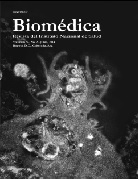Blastocystis sp. frequency and sources among children from 0 to 5 years of age attending public day care centers in Calarcá, Colombia
Abstract
Introduction: There are no reports of the potential sources of Blastocystis sp. in Colombia.
Objectives: To estimate the frequency of Blastocystis sp. and explore possible associations among infection, clinical manifestations and environmental sources.
Materials and methods: A descriptive study was conducted; a representative sample was calculated from a population of 1,993 children less than 5 years old of the lowest socioeconomic levels (1 and 2) attending day care centers in Calarcá, Colombia. The calculated sample size was 275 children, who were selected randomly in 10 % of the centers. Stool testing, questionnaires and sampling to identify the parasite in feces, nails, pets and environmental sources, were performed. Fresh preparations were made with 1% iodine solution, and a concentration technique with formalin-ether was used. Prevalence and odd ratios were estimated; the chi-square test was utilized for qualitative variables, and Student´s t for the quantitative ones.
Results: The prevalence of infection in children was of 57.5%. A statistically significant association was found between the Blastocystis sp. positive stool tests and the presence of the parasite in containers of sugar cane beverage (OR=1.70; 95% CI: 1.05-2.79), wood or ground floors (OR=3.43; 95% CI: 1.12-10.48) and in foods other than bottled milk (OR=3.23; 95% CI: 1.41-4.41). A non-significant high prevalence was found in nails (OR=1.62; 95% CI: 0.99-2.67), as well as a significantly higher prevalence of diarrhea (OR=1.95; 95% CI: 0.99-2.77) in children with Blastocystis sp. (45%) as compared with those without the parasite (33%; p<0.05).
Conclusions: Blastocystis sp. showed a significant association with diarrhea symptoms in children 0 to 5 years old and was widely distributed in the environment and in water. It is necessary to determine if there are specific hosts with pathogenic potential through molecular techniques.
Downloads
Some similar items:
- Constanza Pardo, Ricardo Cendales, Survival analysis of cervical cancer patients , Biomedica: Vol. 29 No. 3 (2009)
- Raúl Murillo, Ricardo Cendales, Carolina Wiesner, Marion Piñeros, Sandra Tovar, Effectiveness of cytology-based cervical cancer screening in the Colombian health system , Biomedica: Vol. 29 No. 3 (2009)
- Sandra Lorena Girón, Julio César Mateus, Fabián Méndez, Impact of an open waste disposal site on the occurrence of respiratory symptoms and on health care costs of children , Biomedica: Vol. 29 No. 3 (2009)
- José Joaquín Carvajal, Ligia Inés Moncada, Mauricio Humberto Rodríguez, Ligia del Pilar Pérez, Víctor Alberto Olano, Characterization of Aedes albopictus (Skuse, 1894) (Diptera:Culicidae) larval habitats near the Amazon River in Colombia , Biomedica: Vol. 29 No. 3 (2009)
- Andrés Páez, Gloria Rey, Carlos Agudelo, Alvaro Dulce, Edgar Parra, Hernando Díaz-Granados, Damaris Heredia, Luis Polo, Outbreak of urban rabies transmitted by dogs in Santa Marta, northern Colombia , Biomedica: Vol. 29 No. 3 (2009)
- Patricia Escobar, Katherine Paola Luna, Indira Paola Hernández, César Mauricio Rueda, María Magdalena Zorro, Simon L. Croft, In vitro susceptibility of Trypanosoma cruzi strains from Santander, Colombia, to hexadecylphosphocholine (miltefosine), nifurtimox and benznidazole , Biomedica: Vol. 29 No. 3 (2009)
- Gustavo Pradilla, Julio César Mantilla, Reynaldo Badillo, Human rabies encephalitis by a vampire bat bite in an urban area of Colombia , Biomedica: Vol. 29 No. 2 (2009)
- Mauricio Beltrán, María Cristina Navas, María Patricia Arbeláez, Jorge Donado, Sergio Jaramillo, Fernando De la Hoz, Cecilia Estrada, Lucía del Pilar Cortés, Amalia de Maldonado, Gloria Rey, Seroprevalence of hepatitis B virus and human immunodeficiency virus infection in a population of multiply-transfused patients in Colombia , Biomedica: Vol. 29 No. 2 (2009)
- Rosa Magdalena Uscátegui, Adriana M. Correa, Jaime Carmona-Fonseca, Changes in retinol, hemoglobin and ferritin concentrations in Colombian children with malaria , Biomedica: Vol. 29 No. 2 (2009)
- Claudia M.E. Romero-Vivas, Luis Eduardo Castro, Lila Visbal, Ana María Santos, Esther Díaz, Cutaneous myiasis by Cochliomyia hominivorax (Coquerel) (Díptera Calliphoridae) in Hospital Universidad del Norte, Soledad, Atlántico , Biomedica: Vol. 29 No. 1 (2009)
| Article metrics | |
|---|---|
| Abstract views | |
| Galley vies | |
| PDF Views | |
| HTML views | |
| Other views | |


























